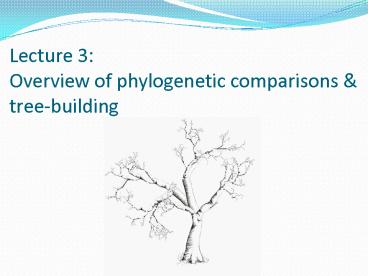Lecture 3: Overview of phylogenetic comparisons PowerPoint PPT Presentation
1 / 11
Title: Lecture 3: Overview of phylogenetic comparisons
1
Lecture 3Overview of phylogenetic comparisons
tree-building
2
Phylogenetic trees
- Definition a tree showing evolutionary
relationships among various biological species or
other entities that are believed to share a
common ancestor. - Features
- Nodes represent most recent common ancestor of
the descendants - Branches may correspond to time estimates or
character substitutions - Rooted contains a unique node corresponding to a
shared common ancestor - Unrooted illustrates relatedness of leaf nodes
without assumptions of common ancestry
3
An example
- Tree constructed using neighbor joining
- Scale bar corresponds to substitutions per
nucleotide position - A variety of Alphaproteobacteria sequences were
used as outgroups - Closed circles represent gt 90 and open circles
gt 70 bootstrap support
Giovannoni et al. 2008
4
Neighbor Joining
- A method used for DNA or protein based trees
- Algorithm requires a distance matrix
- Joins taxa together with similar distance (joins
the closest neighbors) - Based on the minimum-evolution criterion, i.e.
topology providing the least total branch length
is preferred at each step of the algorithm - Does not assume all lineages evolve at the same
rate (no molecular clock assumption) - Computationally efficient
- Con Trees are often close to optimum, but may
not be most accurate
5
ARB distance treeing methods
- ARB Neighbor Joining
- Phylip Distance Methods
- Neighbor joining
- UPGMA (average linking clustering)
- Fitch (additive tree model)
- Kitsch (similar to Fitch but assumes molecular
clock)
Phylip (PHYLogeny Inference Package)
resources http//evolution.genetics.washington.ed
u/phylip.html
6
Maximum Likelihood
- The method searches for the tree with the highest
probability or likelihood. - It evaluates a hypothesis about evolutionary
history in terms of the probability that the
proposed model and the hypothesised history would
give rise to the observed data set. - Statistically well-founded method
- Uses all of the sequence information
- Con requires lots of computational power
7
ARB Maximum Likelihood methods
- FastdnaML computationally slow
- AxML (axelerated maximum likelihood for high
performance computing) - computationally fast - RAxML (randomized axelerated maximum likelihood
for high performance computing) faster yet but
problematic in ARB - PHYML DNA
- TREE-PUZZLE (quartet puzzling tree)
- PHYML - Amino acids
- Phylip PROML
- Protein_ML
8
Maximum Parsimony
- Non-parametric statistical method for estimating
phylogenies - Preferred phylogenetic tree is the tree requiring
the least evolutionary change to explain the data - Con Not statistically consistent
9
ARB Maximum parsimony methods
- Phylip DNAPARS
- Phylip PROTPARS
Phylip (PHYLogeny Inference Package)
resources http//evolution.genetics.washington.ed
u/phylip.html
10
Bootstrapping
- A statistical re-sampling procedure commonly used
for providing confidence to branches in
phylogenetic trees - A measure of repeatability, the probability that
the branch would be recovered if the taxa were
sampled again - Bootstrap percentages are biased, usually towards
an underestimate of confidence (70 might
actually represent 95) - Bootstrapping values are typically presented from
1000 repeated calculations
11
Tutorial 3 objectives
- Add aligned sequences to the ARB database tree
- Refine sequence alignments
- Create a phylogenetic tree in ARB
- Export trees from ARB
- Create trees from web-based resources (RAxML tree)

